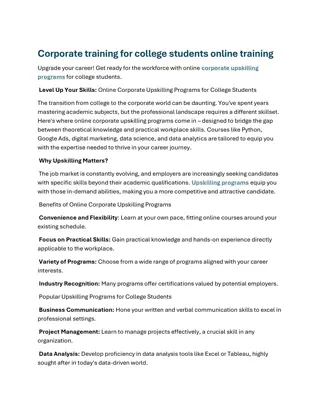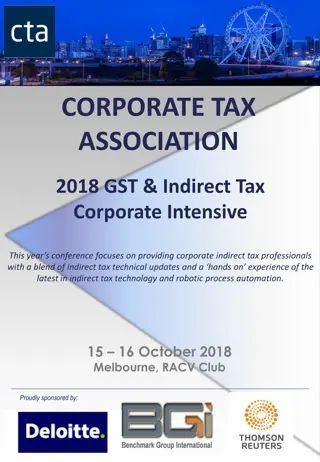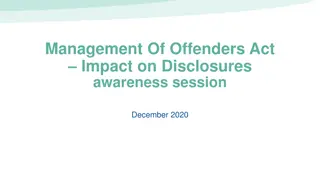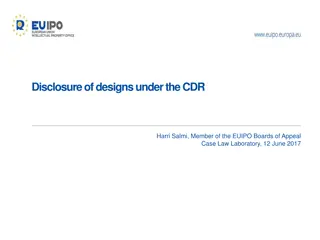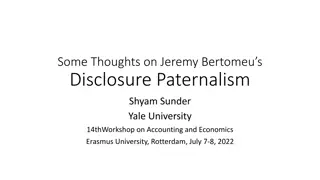Corporate Energy Disclosure Requirements and Methodology
Corporations making energy disclosures on a college website by March 31st, 2021, must include annual UK energy use data, greenhouse gas emissions, methodology used, energy efficiency measures, and emissions intensity ratios. The disclosure covers Scope 1, 2, and 3 emissions, business travel, and methods for calculating grid electricity emissions. The content emphasizes the importance of transparency and sustainability in corporate energy reporting.
- Energy disclosure
- UK corporations
- Greenhouse gas emissions
- Sustainability reporting
- Corporate responsibility
Download Presentation

Please find below an Image/Link to download the presentation.
The content on the website is provided AS IS for your information and personal use only. It may not be sold, licensed, or shared on other websites without obtaining consent from the author. Download presentation by click this link. If you encounter any issues during the download, it is possible that the publisher has removed the file from their server.
E N D
Presentation Transcript
On College website by March 31st2021 5. What should the disclosure include? Corporations making this disclosure should include, as a minimum: its annual UK energy use (in KWh) as a minimum relating to gas, purchased electricity and transport fuel and associated greenhouse gas emissions (in tonnes of carbon dioxide equivalent (CO2e)) the methodology used to calculate the required information a narrative of measures taken to improve energy efficiency in the period of the report an emissions intensity ratio chosen by the corporation. Intensity ratios compare emissions data with an appropriate business metric or financial indicator, such as staff numbers, to allow comparison over time or with other organisations in future years, the prior year equivalent figures should also be disclosed for comparison, but this is not required in the first year
Predecessors have reported from 2009 Two Carbon Management Plans CWA Background Baseline calculated Master spreadsheet set up
Basics Scope 1- primary fuel sources combusted at a site or in an asset owned or controlled by org. Plus bioenergy Scope 2-electricity used by an organisation at sites owned or controlled by them. Scope 3-Transmission and distribution grid losses. Business Travel
Spreadsheets, Spreadsheets, Spreadsheets!
Scope 2 market-based method There are two different methods for calculating grid electricity: 1. Locational grid average: Total emissions from all generation/total electricity generated (e.g. 0.25kg CO2/kWh for the UK) 2. Market-based Method: Contractual arrangement via Renewable Energy Certificates, Guarantees of Origin, or other contract. User can claim the attributes associated with renewable generation (e.g. 0 kgCO2/kWh) Source: GHG Protocol: https://ghgprotocol.org/scope_2_guidance
Types of Transport, where to get info, and which conversion sheet Scope 1- Vehicles Owned- info from Property Services * Scope 3- Fleet cars,( Managed assets) hire cars- info from Property Services-( Business Travel Land) Scope 3- Employee business miles- info from Finance/wages( Business Travel Land)
Hire Vehicles 1/8/19- 31/7/20 2019-20 Hire Vehicles Summary Miles 1/8/19 until 31/7/20 Plug in hybrid Battery electric Type of vehicle Class Petrol miles Diesel miles Unknown Passenger cars Buses and coaches M1 M2 LGV N1 class III Subtotals TOTAL 0 0 0 0 0 0
Fleet Cars/Vans/Minibuses Wisbech Date of Reg Mileage 01/08/18 Mileage 31/07/19 km reading 01/08/19 km reading 31/07/20 Total km Type Category Reg Make Model Total Miles Diesel van (Class III), 1.74 to 3.5 tonne 17 seat Transit Minibus 0 0 Van ZOZ 123 2016 Ford 0 0 0 0 Minibus Diesel, 2198cc, 4600kg, M2 ZOZ 124 2018 Ford Minibus Van Diesel, 1995cc, 3000kg, N1 Need to look up Need to look up ZOZ 125 2019 Ford Van 13441 2717 17496 9164 4,055 6,447 ZOZ 126 Transit ZOZ 127 Ford TOTAL (miles) 10,502 0
Van Categories N1 Class 1 Class ll Class lll less than or equal to 1305kg 1305-1760kg Greater than 1760
Car Size Categories Engine size litres Name Petrol Diesel Car Size Small Up to 1.4 up to 1.7 Medium 1.4-2.0 1.7-2.0 Large 2.0+ 2.0+ Average Unknown
Can be difficult to obtain information on leased rooms Staff numbers not reported as FTE Issues Other benchmarks could include floor area/student numbers Detail required for methods Detail required for narratives
CWA CARBON REDUCTION 2009-2019





